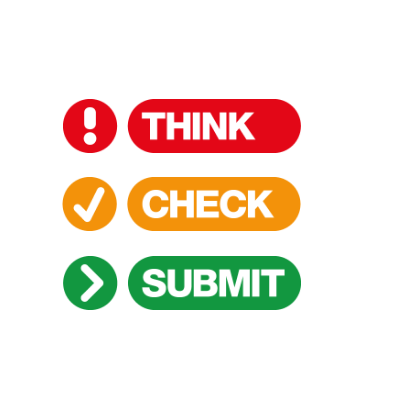Predatory publishers, a growing concern in scholarly publishing, exploit academics seeking outlets for their research. The rise of the article processing charge business model has facilitated their proliferation, posing challenges for authors.
Predatory journals, lacking quality control, peer review, editorial oversight, and preservation services, aim to exploit Open Access models for financial gain. Although a consensus on their definition is lacking, publishing in such journals can result in professional embarrassment, restricted publication options, negative impact on research metrics, and financial loss of publishing fees.
If you have questions or would like assistance in determining the legitimacy of a journal, please contact us.
 We encourage researchers to think critically about journals that they may suspect to be predatory. Think. Check. Submit. is a checklist that prompts you with questions to consider when assessing whether or not a journal is suitable for your research.
We encourage researchers to think critically about journals that they may suspect to be predatory. Think. Check. Submit. is a checklist that prompts you with questions to consider when assessing whether or not a journal is suitable for your research.
We recommend the following resources:
Predatory journals, lacking quality control, peer review, editorial oversight, and preservation services, aim to exploit Open Access models for financial gain. Although a consensus on their definition is lacking, publishing in such journals can result in professional embarrassment, restricted publication options, negative impact on research metrics, and financial loss of publishing fees.
If you have questions or would like assistance in determining the legitimacy of a journal, please contact us.
Common characteristics of predatory journals
Predatory journals often share common characteristics that separate them from legitimate journals. Often, you may receive unsolicited and generalized invitations to submit an article to the publication. Explore some of the red flags in emails and on journal websites 6.- Characteristics of unsolicited emails for predatory journals
- Spamming
- Short deadlines for manuscript submission
- Non-personalized or erroneous salutations
- Scope that doesn't match the researcher's field
- Grammar and spelling errors
- Email addresses that don't reflect the journal's name
- Email submission of manuscripts
- Persuasive language and flattery
- Fake impact metrics
- Characteristics of predatory journal websites
-
- Spelling errors on the website
- Use of distorted or unauthorized images on the website
- The names of editors and journal staff used without permission
- Little to no information on the manuscript handling process
- No use of publication ethics technologies (e.g., ORCID, Crossref, Crossmark, Crosscheck)
Check the legitimacy of a journal
 We encourage researchers to think critically about journals that they may suspect to be predatory. Think. Check. Submit. is a checklist that prompts you with questions to consider when assessing whether or not a journal is suitable for your research.
We encourage researchers to think critically about journals that they may suspect to be predatory. Think. Check. Submit. is a checklist that prompts you with questions to consider when assessing whether or not a journal is suitable for your research.Resources you can consult
While quick listings of predatory and legitimate journals may seem appealing, they alone are inadequate for assessing journal quality. However, utilizing indexes compiled by authoritative sources with strict editorial control can be helpful in evaluating journals for submission.We recommend the following resources:
- Scopus: a large multidisciplinary citation index, with transparent inclusion criteria.
- Web of Science: a large multidisciplinary citation index, with transparent inclusion criteria.
- Norwegian Register for Scientific Journals, Series, and Publishers: a government-run registry of scientific journals which appraises journals for quality.
Further reading
- Cortegiani, A., Misseri, G., Gregoretti, C., Einav, S., & Giarratano, A. (2019). The challenge of the predatory open-access publishing outbreak. European Journal of Anaesthesiology | EJA, 36(11), 810. https://doi.org/10.1097/EJA.0000000000001083
- Moher, D., Shamseer, L., Cobey, K. D., Lalu, M. M., Galipeau, J., Avey, M. T., Ahmadzai, N., Alabousi, M., Barbeau, P., Beck, A., Daniel, R., Frank, R., Ghannad, M., Hamel, C., Hersi, M., Hutton, B., Isupov, I., McGrath, T. A., McInnes, M. D. F., … Ziai, H. (2017). Stop this waste of people, animals and money. Nature, 549(7670), Article 7670. https://doi.org/10.1038/549023a
- Power, H. (2018). Predatory Publishing: How to Safely Navigate the Waters of Open Access. Canadian Journal of Nursing Research, 50(1), 3–8. https://doi.org/10.1177/0844562117748287
- Shamseer, L., Moher, D., Maduekwe, O., Turner, L., Barbour, V., Burch, R., Clark, J., Galipeau, J., Roberts, J., & Shea, B. J. (2017). Potential predatory and legitimate biomedical journals: Can you tell the difference? A cross-sectional comparison. BMC Medicine, 15(1), 28. https://doi.org/10.1186/s12916-017-0785-9
- The challenge of the predatory open-access publishing outbre... : European Journal of Anaesthesiology | EJA. (n.d.). Retrieved 30 May 2023, from https://doi.org/10.1097/EJA.0000000000001083
- Wilson, P. (2022). Unsolicited solicitations: Identifying characteristics of unsolicited emails from potentially predatory journals and the role of librarians. Journal of the Medical Library Association, 110(4), Article 4. https://doi.org/10.5195/jmla.2022.1554
